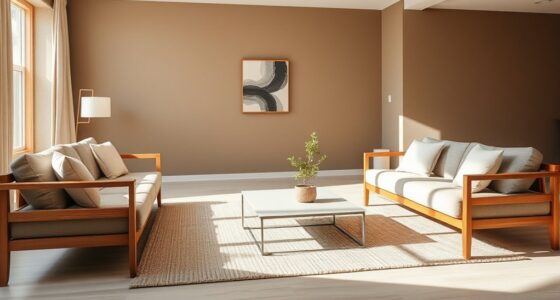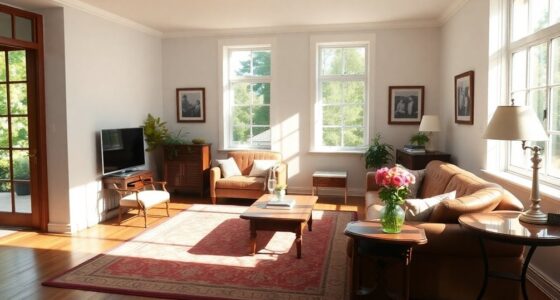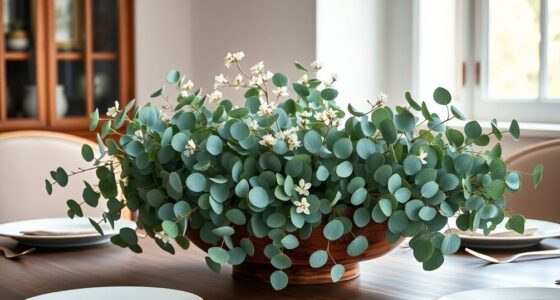Traditional design embraces intricate details, rich colors, and ornate materials, evoking warmth and grandeur. You'll find natural woods and luxurious textiles that create a timeless elegance. In contrast, contemporary design focuses on clean lines, minimalism, and neutral palettes, promoting open spaces and multifunctionality. It often utilizes modern materials like glass and metal, aiming for sustainability and innovation. While traditional spaces feel defined and formal, contemporary layouts encourage social interaction and adaptability. Both styles reveal unique characteristics that shape your environment. Explore further, and you'll discover even more fascinating differences between these two popular design approaches.
Key Takeaways
- Traditional design features intricate details and ornate craftsmanship, while contemporary design emphasizes clean lines and minimalist aesthetics.
- Material choices differ: traditional uses natural woods and rich textiles, whereas contemporary favors modern materials like metal and glass.
- Color palettes vary significantly, with traditional design incorporating warm, rich colors, and contemporary leaning towards neutral and calming shades.
- Layouts in traditional design feature defined, private spaces, while contemporary designs promote open-concept layouts for flexibility and social interaction.
- Historical influences shape traditional design, rooted in European styles, whereas contemporary design reflects modern living trends and multifunctional spaces.
Aesthetic Characteristics
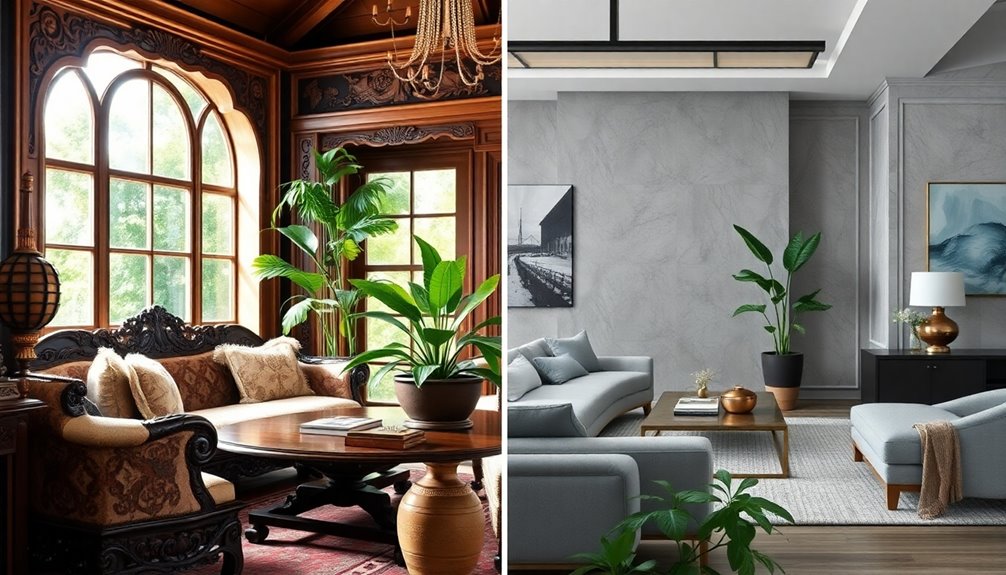
When exploring aesthetic characteristics, you'll notice that traditional and contemporary designs evoke distinct feelings and styles.
Traditional design emphasizes intricate details, with ornate carvings and rich textiles that create a warm, layered aesthetic. You'll find spaces adorned with historical elements, each piece telling a story and infusing the environment with grandeur.
In contrast, contemporary design champions clean lines and minimalism. It favors neutral color palettes, creating an uncluttered and calming atmosphere. Bold accents pop against these muted backgrounds, while geometric patterns add visual interest. Furthermore, modern design's focus on functionality ensures that every element serves a purpose, enhancing the overall usability of the space.
You'll appreciate how contemporary spaces focus on open layouts, promoting flexibility and functionality. Overall, the choice between traditional and contemporary aesthetics significantly affects the ambiance and experience of a space.
Material Choices

Material choices play a crucial role in defining the essence of both traditional and contemporary designs.
In traditional design, you'll find natural woods like oak and walnut, leather upholstery, and rich textiles such as velvet and silk. These materials not only provide durability but also create a sense of warmth and luxury.
Conversely, contemporary design embraces modern materials like metal, glass, and synthetic fabrics. You might see recycled plastics and bio-composite panels, emphasizing sustainability and innovation. Additionally, contemporary designs often use eco-friendly and recycled materials to minimize ecological footprints.
Contemporary designs often feature eco-friendly options and unconventional choices, blending traditional comfort with modern aesthetics.
Color Palettes
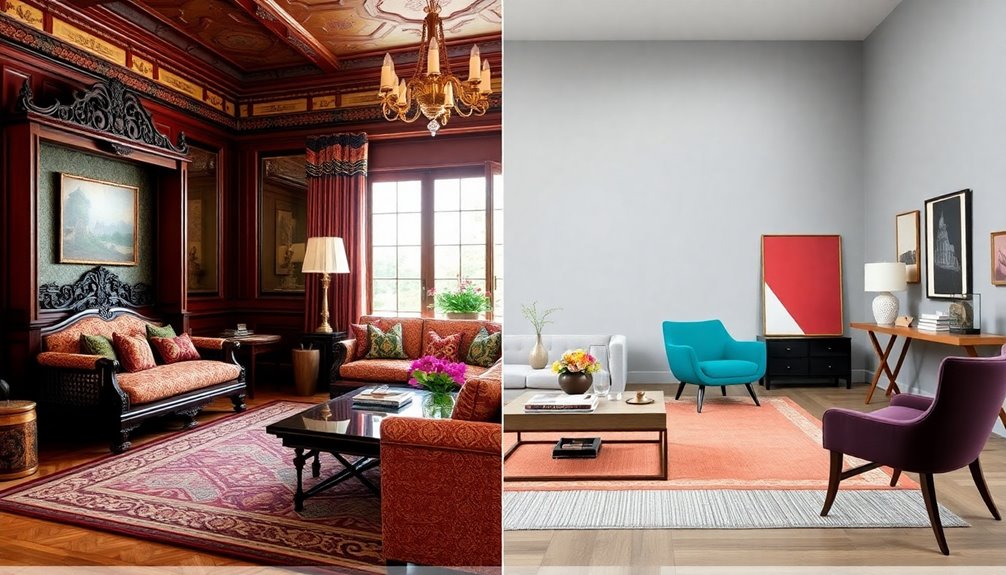
How do color palettes influence the overall feel of a space?
In traditional design, rich and warm colors like deep reds and rich greens create an inviting and luxurious atmosphere. These hues evoke a sense of elegance, often complemented by warm browns and earth tones that add coziness. Additionally, traditional interiors often feature rich, layered textures that enhance the warmth of the color scheme. Incorporating vibrant colors can also add a unique boho flair to traditional spaces.
On the other hand, contemporary design leans towards neutral and calming palettes. Whites and greys dominate, providing a serene backdrop, while touches of blush pink and natural wood tones introduce warmth. Bold colors like mustard yellow or deep blue can energize a space, contrasting beautifully with softer neutrals.
Ultimately, your choice of color palette shapes the mood, making it crucial to consider the emotions you want to evoke in your environment.
Design Techniques
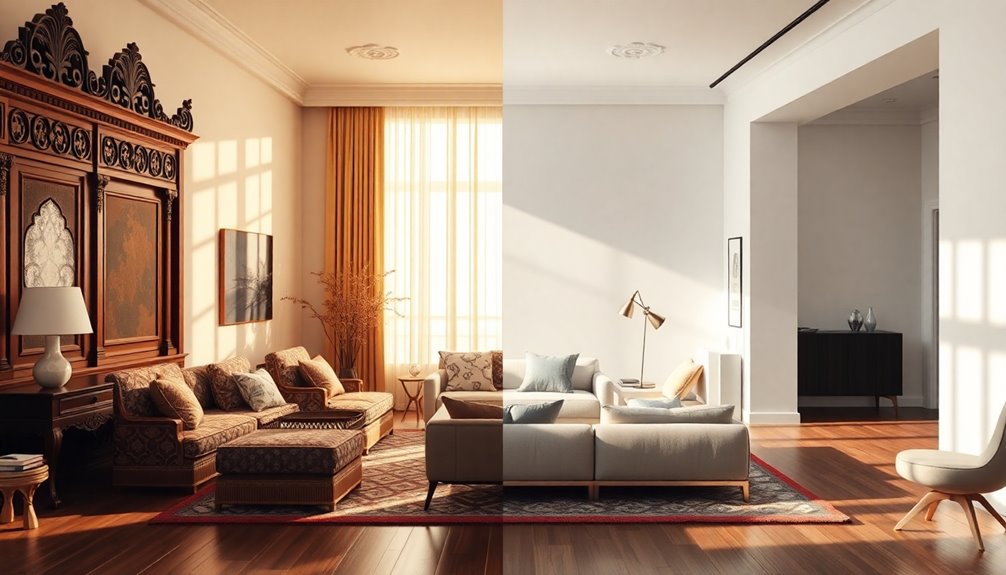
While design techniques play a crucial role in defining a space, they differ significantly between traditional and contemporary styles.
In traditional design, you’ll appreciate the craftsmanship seen in ornate details, rich woodwork, and antique furniture. Historical elements like classic chandeliers and floral prints evoke warmth and nostalgia, while structural elements emphasize curved lines and decorative accents. This style often focuses on comfort and elegance, creating inviting spaces that feel timeless. Incorporating natural materials like wood and stone can further enhance the traditional aesthetic. In addition to its aesthetic appeal, traditional design is rooted in cultural history, often reflecting the values and lifestyles of past generations. The classic design style explained emphasizes a harmonious balance between form and function, ensuring that each piece not only looks beautiful but also serves a purpose. By blending different textures and colors, traditional interiors create a sense of depth and richness that invites relaxation and conversation.
Conversely, contemporary design embraces technological integration and innovative materials such as glass and steel. You'll find open floor plans that promote flexibility, along with multifunctional furniture that adapts to your needs. The fusion of natural and modern materials creates visually engaging textures, while sustainable practices ensure eco-friendly choices. Each style offers unique techniques that shape how you experience your living environment.
Key Characteristics
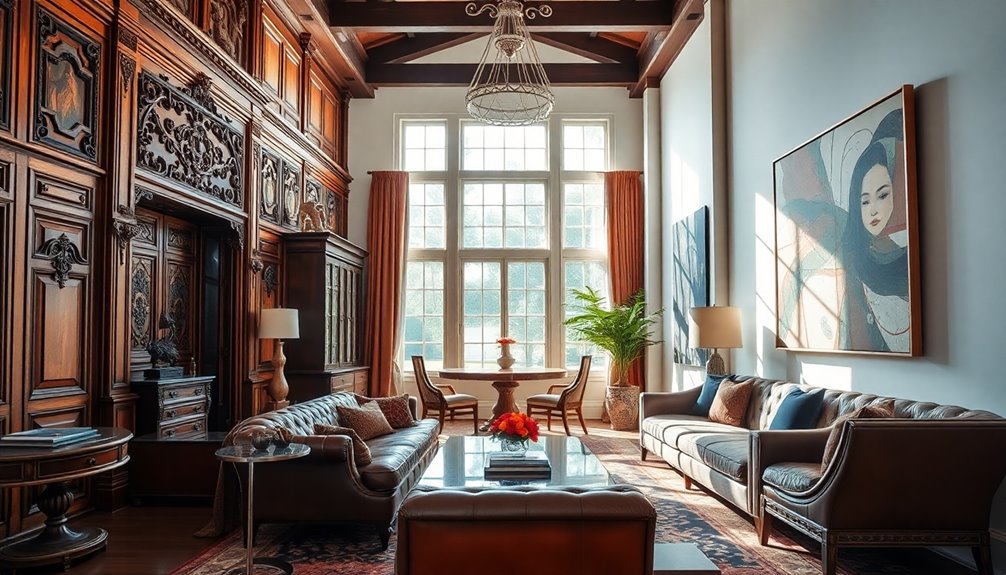
When exploring traditional and contemporary design, understanding their key characteristics helps you appreciate their distinct styles.
Traditional design often showcases warm, rich colors like reds and browns, complemented by neutral backgrounds. You'll notice ornate furniture with intricate carvings and curved lines, typically made from heavy woods like mahogany or walnut. Architectural elements like crown molding and built-in cabinetry add elegance, while classic lighting fixtures and patterned wallpaper enhance the atmosphere. Decorative accessories, including gold and silver accents, contribute sophistication, and area rugs ground the space. In addition, traditional design emphasizes symmetry and balance, creating a harmonious and functional environment.
In contrast, contemporary design typically favors clean lines and a lighter color palette, embracing minimalism.
Recognizing these key traits allows you to differentiate between the two styles effectively.
Maintenance
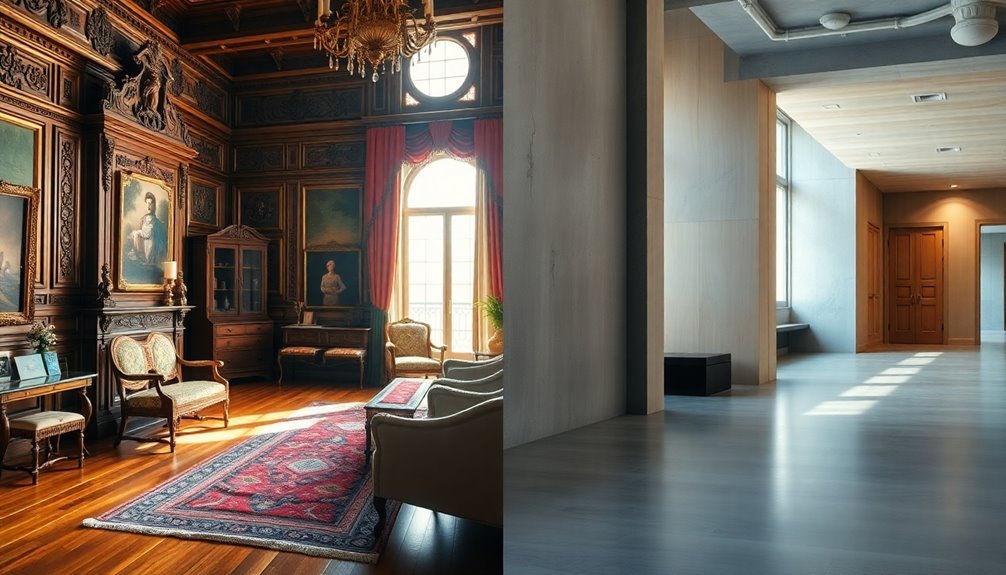
Understanding the maintenance needs of traditional and contemporary homes is crucial for homeowners looking to preserve their investments.
Traditional homes often feature natural materials like wood and stone, which may be durable but require more upkeep and skilled labor. Renovations can be complex due to intricate designs. Additionally, traditional homes often incur higher maintenance costs, which should be considered when budgeting for long-term upkeep.
In contrast, contemporary homes utilize engineered materials such as quartz, which are generally low-maintenance and more straightforward to renovate.
While larger windows in contemporary designs enhance lighting and ventilation, they may need frequent cleaning.
Furniture Styles
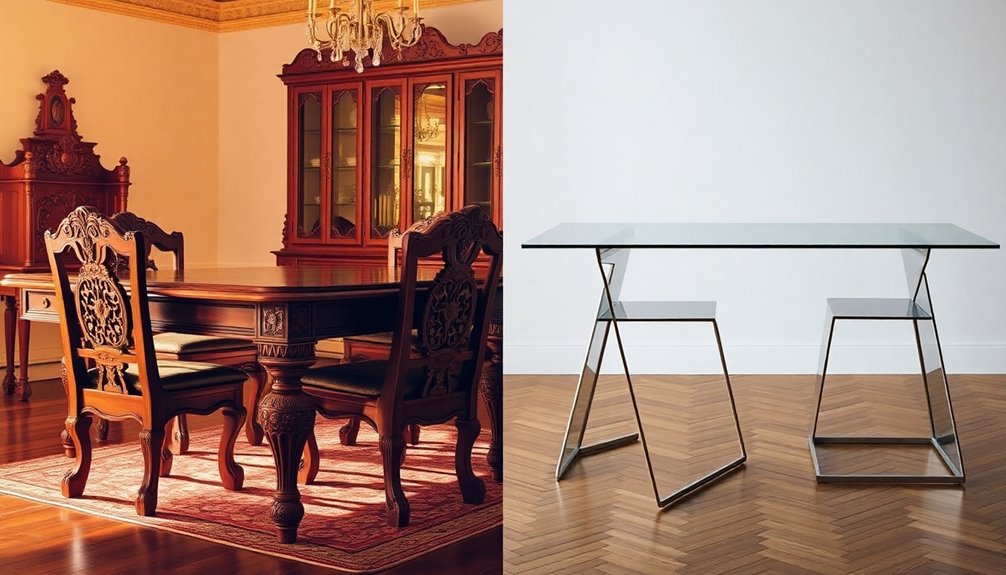
Choosing the right furniture style can greatly enhance the overall aesthetic of your home, complementing both traditional and contemporary designs.
Traditional furniture features curved, ornate lines and symmetrical designs that evoke timeless elegance. You'll appreciate the rich textures, classic upholstery, and warm colors that create a cozy atmosphere. These pieces often include ornately carved details that reflect a rich history.
In contrast, contemporary furniture emphasizes clean lines and sleek silhouettes, often utilizing modern materials like metal and glass. Its minimalist aesthetics and innovative textures offer a fresh, space-efficient look.
When selecting furniture, consider how each style aligns with your personal taste and the ambiance you want to create.
Whether you lean towards comfort and familiarity or modern simplicity, the right choice will reflect your unique style.
Space Arrangement
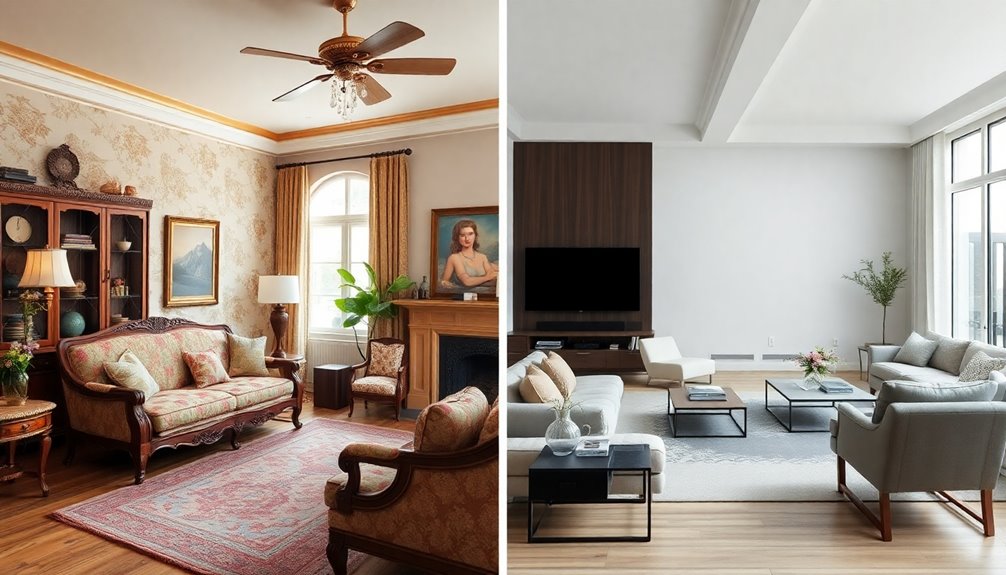
While both traditional and contemporary designs offer unique approaches to space arrangement, they create distinctly different atmospheres in your home.
Traditional layouts emphasize defined spaces, with separate rooms that serve specific purposes, offering privacy and a formal ambiance. You'll find ornate materials and symmetrical arrangements that evoke timeless elegance and historical charm.
In contrast, contemporary designs promote open spaces with minimal barriers, fostering a seamless flow between areas. This layout encourages multifunctionality, where spaces are adaptable for various activities. Open concept layouts also enhance social interaction, making them particularly appealing for entertaining guests.
You'll notice a more relaxed, casual atmosphere in contemporary homes, making them ideal for modern living.
Ultimately, your choice between traditional and contemporary will shape how you experience your home's environment and functionality.
Historical Context
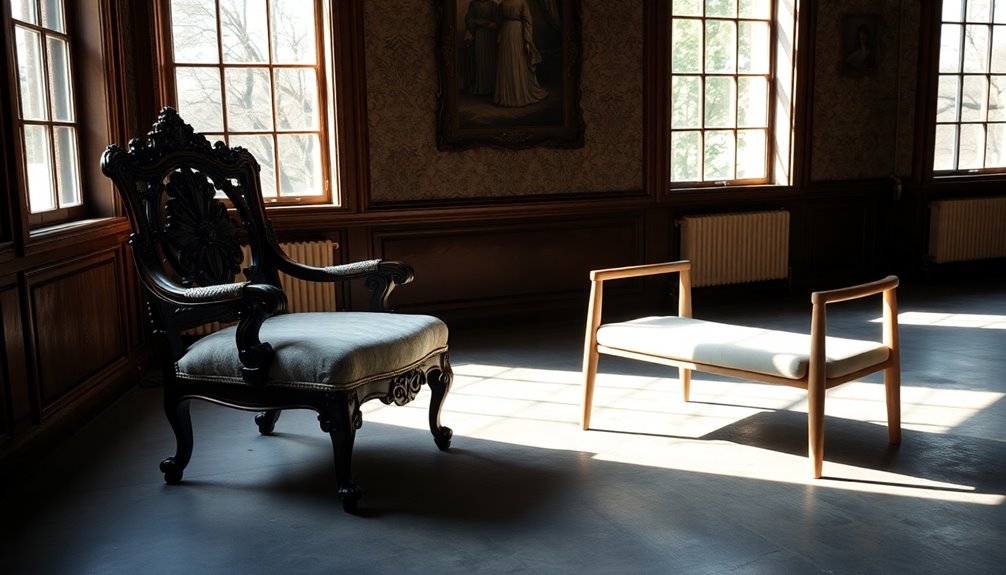
The historical context of traditional and contemporary design reveals how cultural influences shape our living spaces.
Traditional design, rooted in European styles from the 17th and 18th centuries, features ornate elements like giltwood and velvet. The Neoclassical movement brought symmetry and proportion, while the Victorian era blended various historic styles with elaborate details. Modern farmhouse style emphasizes comfort and functionality, showcasing how traditions can evolve over time.
In America, traditional design evolved from colonial roots, showcasing craftsmanship through styles like Queen Anne and Chippendale. Global influences further enriched traditional design, from the symmetry of Chinese layouts to the opulence of Baroque styles. Traditional design in Northern Virginia incorporates Colonial elements, emphasizing wood furnishings and architectural detail.
Over time, movements like Arts & Crafts emphasized simplicity, while modern interpretations continue to honor this rich history, ensuring traditional elements remain relevant and timeless in today's interiors.
Frequently Asked Questions
How Do Traditional and Contemporary Designs Impact Home Value?
Traditional and contemporary designs impact home value significantly.
If you've got a traditional style, its historical richness and ornate details can enhance aesthetic appeal, but you might face maintenance concerns.
On the other hand, contemporary designs with clean lines and functional elements often attract a broader range of buyers, making your home feel modern and move-in ready.
Ultimately, the style you choose can either elevate or limit your home's market value.
Can Traditional and Contemporary Styles Be Mixed in One Space?
Absolutely, you can mix traditional and contemporary styles in one space!
To achieve a harmonious look, focus on balancing elements from both styles. Incorporate traditional pieces like a richly colored armchair alongside sleek, modern furniture.
Use a neutral color palette with bold accents to tie everything together. Remember, it's all about reflecting your personal taste while creating a cohesive feel.
Experiment with textures and materials to add depth and character to your design.
What Are the Costs Associated With Traditional vs. Contemporary Design?
When considering costs associated with traditional versus contemporary design, you need to examine several key factors.
Both styles involve land acquisition, architectural fees, materials, and construction complexity.
Generally, traditional designs might incur higher costs due to premium materials and intricate detailing.
In contrast, contemporary designs may offer flexibility in materials and structures, potentially lowering costs.
You should consult with professionals to get accurate estimates based on your specific project requirements and location.
Which Design Style Is More Eco-Friendly?
When considering which design style is more eco-friendly, it often depends on materials and practices.
Traditional design typically uses natural materials like wood, promoting sustainability if sourced responsibly. It emphasizes natural light and has a focus on durability, reducing waste.
However, if resources aren't managed well, the environmental impact can increase.
You'll want to weigh these factors carefully to determine which style aligns best with your eco-friendly values and goals.
How Do Personal Preferences Influence Design Style Choice?
Personal preferences significantly shape your design style choices.
Your cultural background often influences your affinity for specific colors, patterns, and furnishings. If you value functionality, you'll lean towards practical layouts that suit your lifestyle, especially with children or work needs.
Additionally, your emotional responses to different spaces guide your selections—whether you seek tranquility or vibrant energy.
Ultimately, your unique personality traits steer you towards designs that resonate with who you are.
Conclusion
In the world of design, embracing the differences between traditional and contemporary styles can truly elevate your space. Think of it as a dance—each style has its own rhythm, creating a unique harmony when blended. While traditional design offers timeless elegance, contemporary design breathes fresh air into your surroundings. By understanding these distinctions, you can curate a space that reflects your personality and lifestyle, transforming your home into a beautiful canvas that tells your story.


